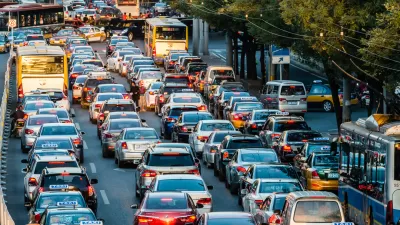Despite efforts to clean up Beijing during last year's Olympic Games, pollutant reductions were very minor, according to a new report.
"Beijing sits in a soupy haze of pollution from nearby factories, coal-fired power plants, and traffic that increases dramatically by the day, making the city one of the most air polluted in the world. China spent billions of dollars trying to control emissions that could hinder athlete's performances on game day. From 20 July to 20 September 2008, the Chinese government temporarily closed factories and regulated the number of cars on the road in Beijing and in nearby areas, all with the hopes of curbing aerosols--fine particles suspended in the atmosphere. China tried a similar traffic strategy in 2006 during a 3-day political summit and achieved 40% to 60% reductions in aerosol concentrations, according to one study. But this study covered only a short period and concentrated on aerosols at ground level, not throughout the larger atmosphere. For the 2008 Olympics, Chinese officials called for reductions of 60% to 70% in automobile emissions and up to 30% in industrial emissions."
"...It turns out that the Chinese only achieved a modest reduction in aerosols. The researchers report in a paper in press in Geophysical Research Letters that pollution-control efforts reduced the overall amount of aerosols in the atmosphere by about 10% to 15%. That small change highlights the importance of factors such as wind direction in determining local pollution, says Cermak. In spite of the reduction in local emissions, winds from the south and southeast sullied Beijing's air by bringing in pollution from distant industrial areas, he says."
FULL STORY: China Falls Short on Olympic Cleanup

Study: Maui’s Plan to Convert Vacation Rentals to Long-Term Housing Could Cause Nearly $1 Billion Economic Loss
The plan would reduce visitor accommodation by 25,% resulting in 1,900 jobs lost.

North Texas Transit Leaders Tout Benefits of TOD for Growing Region
At a summit focused on transit-oriented development, policymakers discussed how North Texas’ expanded light rail system can serve as a tool for economic growth.

Using Old Oil and Gas Wells for Green Energy Storage
Penn State researchers have found that repurposing abandoned oil and gas wells for geothermal-assisted compressed-air energy storage can boost efficiency, reduce environmental risks, and support clean energy and job transitions.

Santa Barbara Could Build Housing on County Land
County supervisors moved forward a proposal to build workforce housing on two county-owned parcels.

San Mateo Formally Opposes Freeway Project
The city council will send a letter to Caltrans urging the agency to reconsider a plan to expand the 101 through the city of San Mateo.

A Bronx Community Fights to Have its Voice Heard
After organizing and giving input for decades, the community around the Kingsbridge Armory might actually see it redeveloped — and they want to continue to have a say in how it goes.
Urban Design for Planners 1: Software Tools
This six-course series explores essential urban design concepts using open source software and equips planners with the tools they need to participate fully in the urban design process.
Planning for Universal Design
Learn the tools for implementing Universal Design in planning regulations.
Ascent Environmental
Borough of Carlisle
Caltrans
Institute for Housing and Urban Development Studies (IHS)
City of Grandview
Harvard GSD Executive Education
Toledo-Lucas County Plan Commissions
Salt Lake City
NYU Wagner Graduate School of Public Service



























